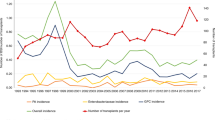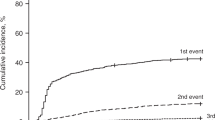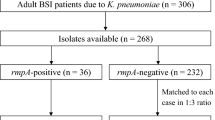Abstract
Carbapenemase-producing Klebsiella pneumoniae (KPC-Kp) infections are an emerging cause of death after hematopoietic stem cell transplantation (HSCT). In allogeneic transplants, mortality rate may rise up to 60%. We retrospectively evaluated 540 patients receiving a transplant from an auto- or an allogeneic source between January 2011 and October 2015. After an Institutional increase in the prevalence of KPC-Kp bloodstream infections (BSI) in June 2012, from July 2012, 366 consecutive patients received the following preventive measures: (i) weekly rectal swabs for surveillance; (ii) contact precautions in carriers (iii) early-targeted therapy in neutropenic febrile carriers. Molecular typing identified KPC-Kp clone ST512 as the main clone responsible for colonization, BSI and outbreaks. After the introduction of these preventive measures, the cumulative incidence of KPC-Kp BSI (P=0.01) and septic shocks (P=0.01) at 1 year after HSCT was significantly reduced. KPC-Kp infection-mortality dropped from 62.5% (pre-intervention) to 16.6% (post-intervention). Day 100 transplant-related mortality and KPC-Kp infection-related mortality after allogeneic HSCT were reduced from 22% to 10% (P=0.001) and from 4% to 1% (P=0.04), respectively. None of the pre-HSCT carriers was excluded from transplant. These results suggest that active surveillance, contact precautions and early-targeted therapies, may efficiently control KPC-Kp spread and related mortality even after allogeneic HSCT.
This is a preview of subscription content, access via your institution
Access options
Subscribe to this journal
Receive 12 print issues and online access
$259.00 per year
only $21.58 per issue
Buy this article
- Purchase on Springer Link
- Instant access to full article PDF
Prices may be subject to local taxes which are calculated during checkout




Similar content being viewed by others
References
Munoz-Price LS, Poirel L, Bonomo RA, Schwaber MJ, Daikos GL, Cormican M et al. Clinical epidemiology of the global expansion of Klebsiella pneumoniae carbapenemases. Lancet Infect Dis 2013; 13: 785–796.
Tzouvelekis LS, Markogiannakis A, Psichogiou M, Tassios PT, Daikos GL . Carbapenemases in Klebsiella pneumoniae and other Enterobacteriaceae: an evolving crisis of global dimensions. Clin Microbiol Rev 2012; 25: 682–707.
Gaibani P, Ambretti S, Berlingeri A, Gelsomino F, Bielli A, Landini MP et al. Rapid increase of carbapenemase-producing Klebsiella pneumoniae strains in a large Italian hospital: surveillance period. Euro Surveill 2011; 16: pii:19800.
Giani T, Pini B, Arena F, Conte V, Bracco S, Migliavacca R et al. Epidemic diffusion of KPC carbapenemase-producing Klebsiella pneumoniae in Italy: results of the first countrywide survey. Euro Surveill 2013; 18: pii:20489.
Hirsch EB, Tam VH . Detection and treatment options for Klebsiella pneumoniae carbapenemases (KPCs): an emerging cause of multidrug-resistant infection. J Antimicrob Chemother 2010; 65: 1119–1125.
Gupta N, Limbago BM, Patel JB, Kallen AJ . Carbapenem-resistant Enterobacteriaceae: epidemiology and prevention. Clin Infect Dis 2011; 53: 60–67.
Bergamasco MD, Barroso Barbosa M, de Oliveira Garcia D, Cipullo R, Moreira JC, Baia C et al. Infection with Klebsiella pneumoniae carbapenemase (KPC)-producing K. pneumoniae in solid organ transplantation. Transpl Infect Dis 2012; 14: 198–205.
Lanini S, Costa AN, Puro V, Procaccio F, Grossi PA, Vespasiano F et al. Incidence of carbapenem-resistant gram negatives in Italian transplant recipients: a nationwide surveillance study. PLoS ONE 2015; 10: e0123706.
Clancy CJ, Chen L, Shields RK, Zhao Y, Cheng S, Chavda KD et al. Epidemiology and molecular characterization of bacteremia due to carbapenem-resistant Klebsiella pneumoniae in transplant recipients. Am J Transplant 2013; 13: 2619–2633.
Satlin MJ, Jenkins SG, Walsh TJ . The global challenge of carbapenem-resistant Enterobacteriaceae in transplant recipients and patients with hematologic malignancies. Clin Infect Dis 2014; 58: 1274–1283.
Girmenia C, Rossolini GM, Piciocchi A, Bertaina A, Pisapia G, Pastore D et al. Infections by carbapenem-resistant Klebsiella pneumoniae in SCT recipients: a nationwide retrospective survey from Italy. Bone Marrow Transplant 2015; 50: 282–288.
Girmenia C, Viscoli C, Piciocchi A, Cudillo L, Botti S, Errico A et al. Management of carbapenem resistant klebsiella pneumoniae infections in stem cell transplant recipients: an italian multidisciplinary consensus statement. Haematologica 2015; 100: e373–e376.
Zuckerman T, Benyamini N, Sprecher H, Fineman R, Finkelstein R, Rowe JM et al. SCT in patients with carbapenem resistant Klebsiella pneumoniae: a single center experience with oral gentamicin for the eradication of carrier state. Bone Marrow Transplant 2011; 46: 1226–1230.
Satlin MJ, Calfee DP, Chen L, Fauntleroy KA, Wilson SJ, Jenkins SG et al. Emergence of carbapenem-resistant Enterobacteriaceae as causes of bloodstream infections in patients with hematologic malignancies. Leuk Lymphoma 2013; 54: 799–806.
Dellinger RP, Levy MM, Rhodes A, Annane D, Gerlach H, Opal SM et al. Surviving sepsis campaign: international guidelines for management of severe sepsis and septic shock: 2012. Crit Care Med 2013; 41: 580–637.
Angus DC, van der Poll T . Severe sepsis and septic shock. N Engl J Med 2013; 369: 2063.
Struelens MJ, Rost F, Deplano A, Maas A, Schwam V, Serruys E et al. Pseudomonas aeruginosa and Enterobacteriaceae bacteremia after biliary endoscopy: an outbreak investigation using DNA macrorestriction analysis. Am J Med 1993; 95: 489–498.
Gooley TA, Leisenring W, Crowley J, Storer BE . Estimation of failure probabilities in the presence of competing risks: new representations of old estimators. Stat Med 1999; 18: 695–706.
Fine JP, Gray RJ . A proportional hazards model for the subdistribution of a competing risk. J Am Stat Assoc 1999; 94: 496–509.
Bratu S, Landman D, Alam M, Tolentino E, Quale J . Detection of KPC carbapenem-hydrolyzing enzymes in Enterobacter spp. from Brooklyn, New York. Antimicrob Agents Chemother 2005; 49: 776–778.
Limbago BM, Rasheed JK, Anderson KF, Zhu W, Kitchel B, Watz N et al. IMP-producing carbapenem-resistant Klebsiella pneumoniae in the United States. J Clin Microbiol 2011; 49: 4239–4245.
Zarkotou O, Pournaras S, Tselioti P, Dragoumanos V, Pitiriga V, Ranellou K et al. Predictors of mortality in patients with bloodstream infections caused by KPC-producing Klebsiella pneumoniae and impact of appropriate antimicrobial treatment. Clin Microbiol Infect 2011; 17: 1798–1803.
Mathers AJ, Cox HL, Bonatti H, Kitchel B, Brassinga AK, Wispelwey B et al. Fatal cross infection by carbapenem-resistant Klebsiella in two liver transplant recipients. Transpl Infect Dis 2009; 11: 257–265.
Passweg JR, Baldomero H, Bader P, Bonini C, Cesaro S, Dreger P et al. Hematopoietic stem cell transplantation in Europe 2014: more than 40000 transplants annually. Bone Marrow Transplant 2016; 51: 1–7.
Warburg G, Hidalgo-Grass C, Partridge SR, Tolmasky ME, Temper V, Moses AE et al. A carbapenem-resistant Klebsiella pneumoniae epidemic clone in Jerusalem: sequence type 512 carrying a plasmid encoding aac(6')-Ib. J Antimicrob Chemother 2012; 67: 898–901.
Amit S, Mishali H, Kotlovsky T, Schwaber MJ, Carmeli Y . Bloodstream infections among carriers of carbapenem-resistant Klebsiella pneumoniae: etiology, incidence and predictors. Clin Microbiol Infect 2015; 21: 30–34.
Taglietti F, Di Bella S, Galati V, Topino S, Iappelli M, Petrosillo N . Carbapenemase-producing Klebsiella pneumoniae-related mortality among solid organ-transplanted patients: do we know enough? Transpl Infect Dis 2013; 15: E164–E165.
Tumbarello M, Viale P, Viscoli C, Trecarichi EM, Tumietto F, Marchese A et al. Predictors of mortality in bloodstream infections caused by Klebsiella pneumoniae carbapenemase-producing K. pneumoniae: importance of combination therapy. Clin Infect Dis 2012; 55: 943–950.
Acknowledgements
Institutional funding has supported this work. The corresponding author had full access to all the data in the study and had the final responsibility for the decision to submit for publication.
Author information
Authors and Affiliations
Corresponding author
Ethics declarations
Competing interests
The authors declare no conflict of interest.
Rights and permissions
About this article
Cite this article
Forcina, A., Baldan, R., Marasco, V. et al. Control of infectious mortality due to carbapenemase-producing Klebsiella pneumoniae in hematopoietic stem cell transplantation. Bone Marrow Transplant 52, 114–119 (2017). https://doi.org/10.1038/bmt.2016.234
Received:
Revised:
Accepted:
Published:
Issue Date:
DOI: https://doi.org/10.1038/bmt.2016.234
This article is cited by
-
Decrease in Mortality from Sepsis: Impact of the Multidisciplinary Program for the Hematologic Patient at Very High Risk
Indian Journal of Hematology and Blood Transfusion (2023)
-
Different screening frequencies of carbapenem-resistant Enterobacteriaceae in patients undergoing hematopoietic stem cell transplantation: which one is better?
Antimicrobial Resistance & Infection Control (2020)
-
Pushing the Limits: Machine Preservation of the Liver as a Tool to Recondition High-Risk Grafts
Current Transplantation Reports (2018)



